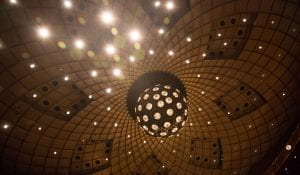
The October 8, 2021 evening program opened with La Valse, a showcase for many of the New York City Ballet dancers, set to Balanchine’s lyrical choreography and Maurice Ravel’s ominous score in timeless costumes of Karinska—burgundies, blacks, whites. Kudos to Lauren King and Devin Alberda in their carefree, light, playful waltz; at one point King sweetly prances on point. In Georgina Pazcoguin and Daniel Applebaum’s waltz, it is Applebaum who attracts all the attention. Ashley Laracey and Andrew Scordato also impress. They lengthen and deepen each movement, a grand battement becoming a precious variation; nothing is rushed with this musical pairing. Some of the playfulness in these pas de deux is mirrored in the second movement by Sterling Hyltin and Joseph Gordon—the very architecture of the piece is on display—winding arms, small gestures, luxurious extensions. Ease and confidence, too, is evident. A fury of dance follows a beautiful ensemble of waltzes, but it is Hyltin’s exhaustive moves with death that are exciting to watch.
Other Dances, originally set on Natalia Makarova and Mikhail Baryshnikov, featured Tiler Peck and Gonzalo Garcia, dancing to Robbins and Chopin, with Elaine Chelton on piano. The Peck-Garcia coupling was stunning. Peck plays with the piece, its energy and dynamics—rapid piqué, and slow, slow balances. Her développé, elevé arabesque, is exceptionally light. Peck looks like she could be parting water, pushing aside heavy air, creating a lighter space. That imagery is to be expected in such a superb Robbins dancer—lyrical, musical, versatile. Dancing the entire stage, both Peck and Garcia make the dance look natural, their arms and legs a logical expressions of mood and intent. With beautiful overhead lifts, Garcia carries Peck as if she is weightless. And with his virtuoso petit batterie, he is a serious, thoughtful dancer. The couple, together, make every move count.
In After the Rain, principal Lauren Lovette, partnered by corps dancer Preston Chamblee dance Christopher Wheeldon’s choreography to the music of Kurt Nikkanen’s violin and Nancy McDill’s piano in a gorgeous Arvo Pärt score. In this tender piece, the focus is on Lovette, guided by an attentive Chamblee. The movement is slow and deliberate as the dancers fold, stretch, contract, expand. Their back bends are exceptionally deep—a glorious ode of flexibility.
Balanchine’s Agon concludes the program. One of Balanchine’s modernist black and white ballets, this piece is nonstop dance. Dancers Maria Kowroski, Megan LeCrone, Sara Adams, Ashley Hod, Amar Ramasar, Anthony Huxley, Sebastian Villarini-Velez, and Andres Zuniga are featured in this Balanchine-Stravinsky piece. The black and white motif serves to accentuate the change in dynamics—sometimes taffy-like, other times percussive. It’s a fast-paced piece, with big dancing that covers a lot of space, and extensions with perfectly-placed feet, flexed wrists, strong gestures. Of particular note are LeCrone’s balances and Villarini-Velez’s stunning turns. Kowroski and Ramasar wind themselves around each other, Kowroski with beautiful lines and arabesques and penché full of breath, and Ramasar, contortionist-like, but with magnificent jumps—his landings, picture-perfect, soft. Perhaps suggestive of a contest, Agon is a display of fast and articulate dancing, with many daring steps. This inventive Balanchine piece, full of power and dynamics, still looks fresh and contemporary after sixty-plus years.